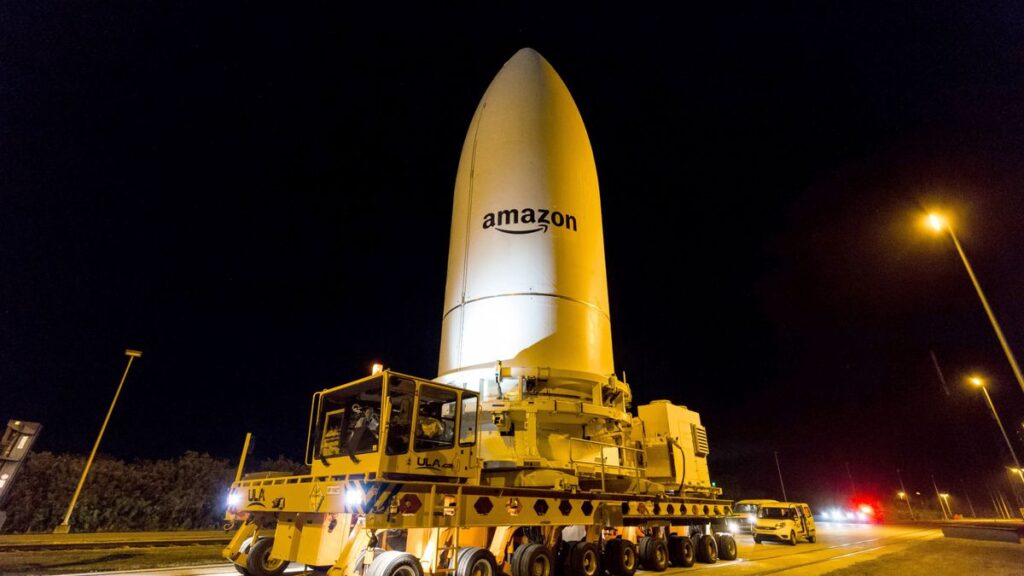CAPE CANAVERAL, Fla. — NASA is now targeting early next year for the maiden launch of its next megarocket: the Space Launch System.
The behemoth moon rocket, the first since the Apollo program, is months behind schedule (it was initially slated to launch in November) but could now potentially fly Feb. 12 if its final tests go well, NASA officials said Friday (Oct. 22). That’s when the first launch window opens for its uncrewed Artemis 1 mission around the moon, they said.
The Space Launch System, or SLS, is the rocket NASA is developing to take astronauts to the moon, Mars and other distant destinations as part of the agency’s Artemis program, which aims to send astronauts back to the moon as early as 2024 to establish a long-term, sustainable human presence on and around Earth’s nearest neighbor.
It’s composed of two major components: the SLS rocket and Orion crew capsule. On Wednesday (Oct. 20), engineers stacked the crew capsule atop its 322-foot-tall mega launcher inside High Bay 3of the historic Vehicle Assembly Building (VAB) at the Kennedy Space Center in Florida. The stacking marked the completion of a major milestone for the agency and its countdown to launch.
In photos: The Orion space capsule: NASA’s next spaceship
Together, the duo will fly the first mission in NASA’s Artemis lunar program, as part of an uncrewed flight around the moon that’s targeted to launch early next year. The flight, called Artemis 1, is estimated to launch as early as Feb. 12.
“Completing stacking is a really important milestone,” Mike Sarafin, NASA’s Artemis 1 program manager said during a news briefing Friday (Oct. 22) to discuss the program’s progress. “It shows that we’re in the homestretch toward the mission.”
During the same briefing, Tom Whitmeyer, deputy associate administrator for exploration systems development at NASA Headquarters, told reporters that the now-stacked rocket and crew capsule will roll out to their Launch Pad 39B in late December for testing, followed by a fueling exercise known as a wet-dress rehearsal in early January.
“After the wet-dress rehearsal, we will go back to the VAB for more checkouts and then roll back out to the pad one more time,” he said.
“Artemis 1 is the first step in order to land the first woman and the first person of color on the moon,” Whitmeyer added,” It’s a very important achievement for this country and we’re excited about the mission’s progress so far.”
The road to launch

Engineers from NASA centers across the country have contributed to the development of the SLS, with the bulk of the rocket’s hardware assembled and tested in NASA’s Michoud Assembly Facility (in Louisiana) and Stennis Space Center in Mississippi.
The rocket is powered by a core stage that sits atop four RS-25 engines (the same type of engine that was used on the space shuttle) and two massive solid rocket boosters that produce a total of 8.8 million pounds of thrust.
The core stage and four main engines were fired up twice this year as part of a hot-fire test that was meant to make sure the rocket’s components were working properly. The first attempt (on Jan. 16) ended prematurely as the engines shut down just over a minute after ignition.
The early shutdown was attributed to an anomaly in one engine’s hydraulic system; that system apparently exceeded conservatively preset limits in one parameter, triggering a shutdown, investigators determined. NASA opted to redo the test in March ahead of shipping it to the launch site.
Once it arrived in Florida, the SLS was transported to High Bay 3 inside the Vehicle Assembly Building — the same building where NASA engineers built the Saturn V moon rocket — where crews have been working diligently to assemble the massive rocket’s different systems, which culminated in topping the vehicle with its Orion crew capsule earlier this week.

Path to the pad
Following checkouts at the launch pad later this year, the SLS will roll back to its launch pad in early January for its final major test before launch: a wet dress rehearsal. Essentially a fueling test, the testis the final checkout of both the rocket and ground systems. As such, NASA’s launch team will load the vehicle’s cryogenic fuel (liquid hydrogen and liquid oxygen) into both the core stage and the upper stage.
The teams will run through launch day procedures all the way up to liftoff. The rocket will then be moved back to its massive hangarto await its launch date. Sarafin said the first launch opportunity is a 15-day window that opens on Feb. 12.
If that launch target remains fixed, a big challenge for the agency, theSLS will roll to the pad six days prior to its planned liftoff on Feb. 12. NASA has a 21-minute launch window on that day that opens at 5:56 p.m. EST (2256 GMT), with its other opportunities varying day-by-day. Sarafin also said that launch windows could be adjusted by a minute or two on launch day, depending on trajectory analysis.
Launch windows
According to Sarafin, the length of each launch window could vary from tens of minutes up to two hours, with the first launch period running from Feb. 12 to 27. He said there are additional opportunities in March and April, with each period open for approximately two weeks.
“We’re on for roughly two weeks, and then we’re off for about two weeks,” he said.
When asked why the launch windows were so varied, Sarafin said that there are two main driving factors: the locations of the Earth and the moon, and a daylight splashdown for Orion.
“[The launch window] really has to do with the three-body problem that we’re dealing with,” he said during the briefing. “”We have the Earth rotating on its axis. We have the moon going about the Earth in its lunar cycle in its … lunar cycle. And then we’ve got to head outbound, and then splash down in a set of daylight landing conditions.”
But that’s not all. The length of the mission will also vary depending on when SLS launches, says Sarafin. If it can get off the ground during the first half of its first launch period (Feb. 12-27), the Artemis 1 mission would run for about six weeks, versus four weeks later in the month.
Mission objectives
The goal of the Artemis 1 mission is to put the launcher-capsule system through its paces ahead of its second flight, and first-planned crew launch, Artemis 2. That flight is scheduled to blast off sometime in 2023 but would not land on the moon. Instead, it would orbit the moon and set the stage for a lunar landing soon after.
Sarafin said the Artemis 1 mission will also test how well Orion can return from the moon in lunar reentry conditions. As a bonus, it will give engineers data on how the vehicle operates while flying through space. Orion will beam that data back via the Deep Space Network, along with some epic selfies thanks to a couple of cameras mounted on the spacecraft’s solar arrays.
Related stories:
“Orion is going to take selfies of itself, and we’ll see the moon in the background and way off in the distance,” Sarafin said. “We’re going to see the Earth some 270,000 miles away, and really gain a new perspective for the Artemis generation.”
In addition to the Orion capsule, the SLS rocket will also ferry 10 cubesats, or small satellites, which will perform a variety of tasks from studying the effects of deep-space radiation on yeast DNA, to flying by a Near-Earth Asteroid with the help of a massive solar sail.
Follow Amy Thompson on Twitter @astrogingersnap. Follow us on Twitter @Spacedotcom or Facebook.


